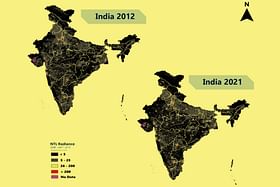The analysis through the report shows an overall Night Time Light (NTL) radiance increase in India by 43 per cent between 2012 and 2021.
The data through these satellite images can be correlated with spatial transformations, infrastructure development and economic growth.
The National Remote Sensing Centre (NRSC) released the Atlas document to display a decade’s worth of changes in Night Time Light (NTL) over India. The study prepared by the centre under the Indian Space Research Organisation (ISRO) covers the period from 2012 to 2021.
The images developed by the NRSC uses data from National Aeronautics and Space Administration (NASA) and National Oceanic and Atmospheric Administration (NOAA) and the result provided is the combined radiance over the total geographical area.
The analysis through the report shows an overall NTL radiance increase in India by 43 per cent between 2012 and 2021. According to this Atlas, some Indian states saw a growth of over 400 per cent in the past decade.
A significant increase was observed in Bihar with a growth of 474 per cent. Furthermore, Manipur and Ladakh recorded a 441 per cent and 280 per cent growth, respectively.
Kerala observed an increase of 119 percent, while Arunachal Pradesh saw 66 per cent growth. Madhya Pradesh, Uttar Pradesh and Gujarat showed an increment of 66 per cent, 61 per cent and 58 per cent respectively.
Other larger and developing states also observed an increase over the decade as per the data in the report.
The Importance Of Data
Measuring the NTL change data can help in providing important insights and can be considered as a growth indicator for assessment of development patterns over a specific time period.
The data through these satellite images can be correlated with spatial transformations, infrastructure development and economic growth.
This includes the increased extent of electricity connections, to nearly three crore households in different areas of the country made possible under the Saubhagya scheme.
The Central government initiated the Pradhan Mantri Sahaj Bijli Har Ghar Yojana – Saubhagya scheme in October 2017, with the goal of extending electricity connections.
This included all rural households without electricity and all economically challenged urban households, in an effort to achieve universal household electrification nationwide.
Further, the Ujala scheme that was undertaken in 2015 to distribute 36.78 crore LEDs across the country, would have additionally contributed.
India has been experiencing tremendous growth in its network of roads with construction of almost 50,000 km of national highways and road infrastructure over the past years.
The Bharatmala scheme is envisioned to seamlessly provide a connecting ecosystem through its road networks across the country.
This includes economic corridors, coastal roads and ports connectivity, expressways and arterial road connections, well equipped with top facilities including lighting and electricity infrastructure, which all adds up to the luminosity.
This decadal data has showcased the transformation that the different regions of India are undergoing. This is expected to increase further, considering the pace and engagements in infrastructure development and consequently, economic growth.


